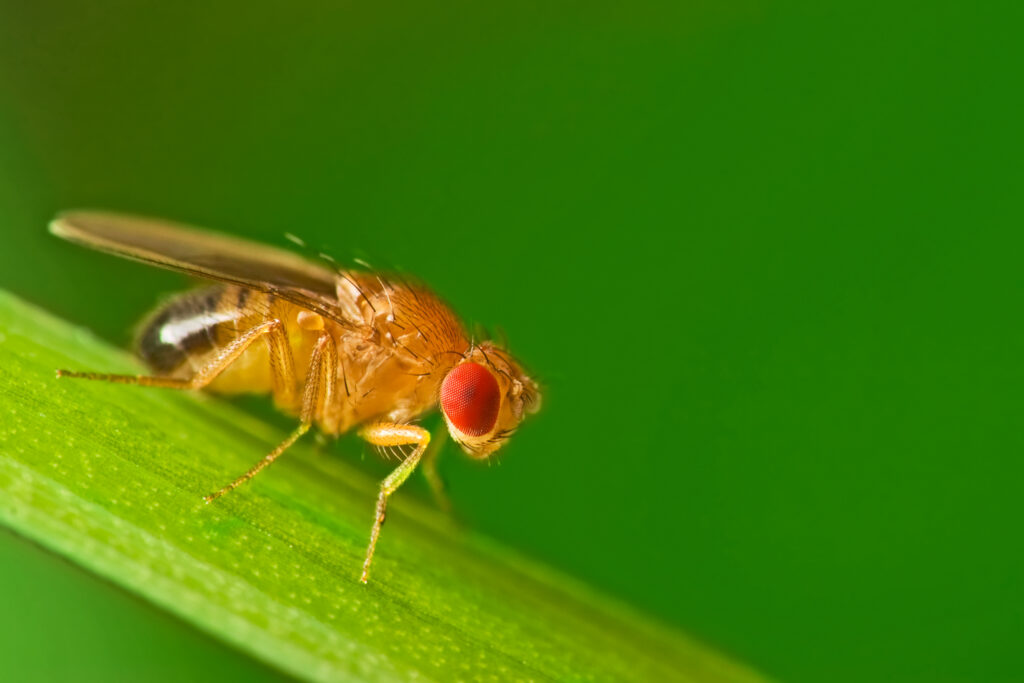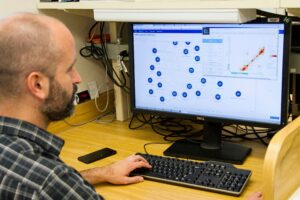
Male common fruit fly (Drosophila Melanogaster) - about 2 mm long - sitting on a blade of grass with green foliage background
A groundbreaking study from Stanford University has uncovered new insights into how fruit fly populations maintain genetic diversity in rapidly changing environments. This research is crucial for understanding how species can survive future challenges, such as climate change and human-induced habitat alterations. The study provides the first direct evidence supporting the theory of “dominance reversal” in genetics, where genetic variants can switch between dominant and recessive roles depending on environmental conditions.
Published in the journal Nature Ecology and Evolution on September 15, the study tracked the evolution of fruit fly populations in a controlled outdoor orchard, revealing how these insects develop long-term resistance to pesticides. This discovery challenges the traditional view of genetic variants as being strictly dominant or recessive, suggesting a more dynamic interplay influenced by environmental factors.
Unraveling the Genetic Puzzle
Populations living in rapidly changing environments face numerous challenges, from fluctuating food sources to human activities reshaping their habitats. This raises a fundamental question for scientists: How do populations maintain the genetic diversity needed to survive future challenges when natural selection typically eliminates less useful variants over time?
Researchers at Stanford have addressed this puzzle by observing fruit fly populations in an outdoor orchard, where they controlled pesticide exposure over time. Their experiments, combined with mathematical modeling, offer compelling evidence for dominance reversal—a mechanism where the same genetic variant can be dominant when beneficial and recessive when harmful.
“Let’s say you haven’t used pesticides for 20 years. The moment you add pesticides again, they’ll rapidly respond and resist them,” said Dmitri Petrov, senior author and professor of biology at Stanford. “It’s like the flies have a hidden shield. When they don’t need it, it’s not in their way. But it’s ready as soon as they are threatened.”
Mechanisms of Dominance Reversal
The concept of dominance reversal suggests that genetic variants can switch roles based on environmental conditions. For instance, in pesticide-rich environments, resistance alleles become dominant, providing protection. Conversely, in pesticide-free settings, these alleles become recessive, minimizing any negative impact on fitness.
Marianthi Karageorgi, the study’s lead author and a research scientist in the Petrov Lab, noted that this mechanism might be widespread in nature. “What we’re seeing could be a general mechanism for populations to hold on to genetic variants they might need for future environmental shifts,” she explained. This adaptability could have been operating in nature for millions of years, particularly in response to chemical defenses in plants.
Experimental Evolution in Action
Since the 1950s, the theory of dominance reversal has intrigued population geneticists, but testing it in natural settings proved challenging. The Stanford team combined genetic surveys, lab experiments, field experiments, and mathematical models to provide empirical evidence for this phenomenon.
Before conducting experiments, researchers analyzed genetic data from flies in various environments, including organic farms. Collaborating with Paul Schmidt from the University of Pennsylvania, they assessed how different genetic variations affected fly fitness with and without pesticide exposure.
“It’s like the flies have a hidden shield. When they don’t need it, it’s not in their way. But it’s ready as soon as they are threatened,” reiterated Dmitri Petrov.
The team confirmed that pesticide-resistant alleles persisted at intermediate frequencies over time. When dominant without pesticides, these alleles negatively impacted survival and reproduction, supporting the dominance reversal hypothesis.
Implications and Future Directions
The study’s findings have significant implications for understanding how populations adapt to environmental changes. By demonstrating that genetic variants can switch roles based on environmental pressures, the research highlights the complexity of evolutionary processes.
Furthermore, the study raises foundational questions about how selective pressures impact genomic diversity over time. The researchers suggest that dominance reversal could be a key factor in maintaining genetic diversity, even setting the levels of diversity in natural populations.
“This field is trying to understand what forces are involved in evolution, how you measure them, and how much of an effect they have. But often these forces are hidden from us,” said Petrov. “So, the big question for us continues to be: How do we wrestle that knowledge from recalcitrant nature?”
As scientists continue to explore the intricacies of genetic adaptation, the Stanford study provides a valuable framework for future research. By shedding light on the dynamic nature of genetic roles, this research opens new avenues for understanding how species can thrive in an ever-changing world.





